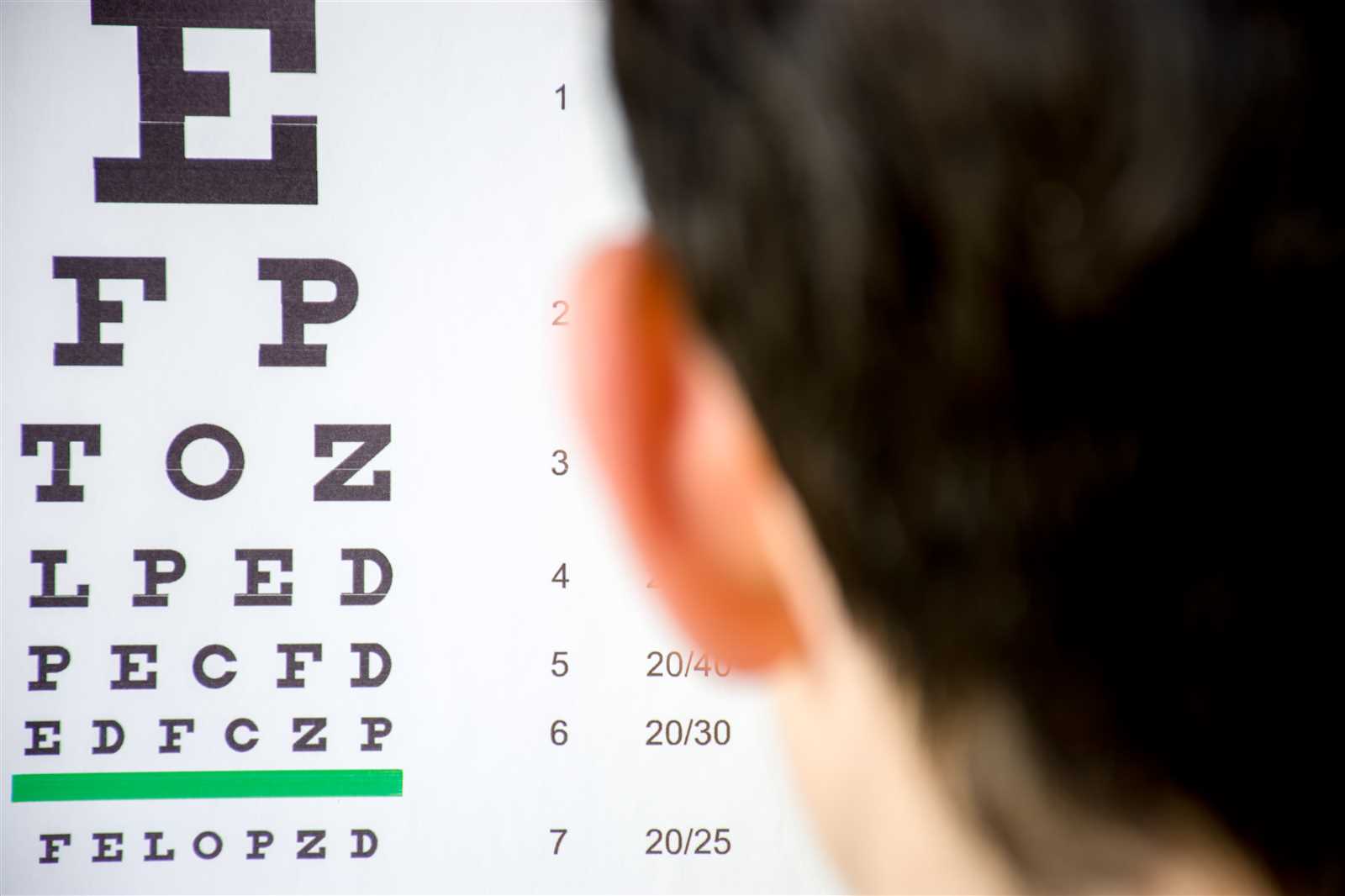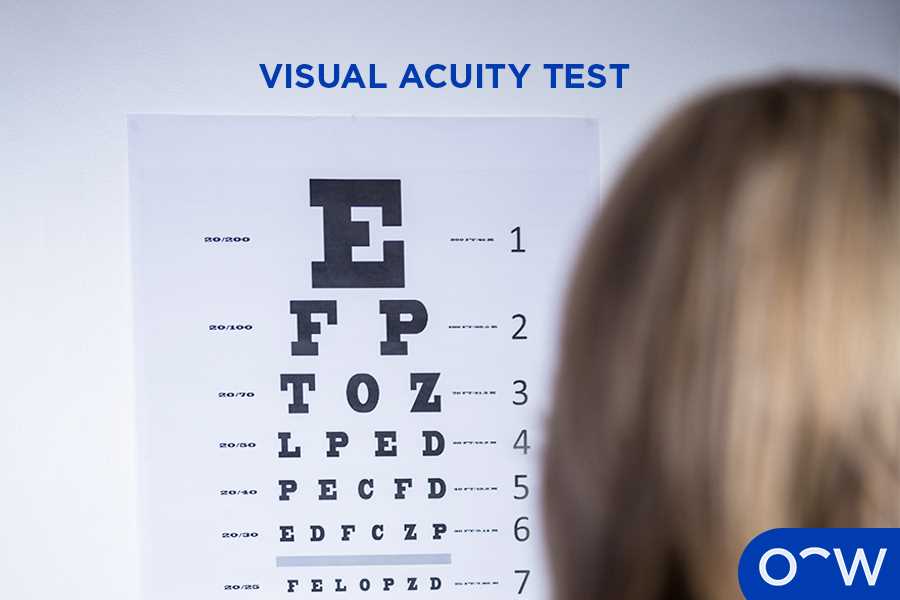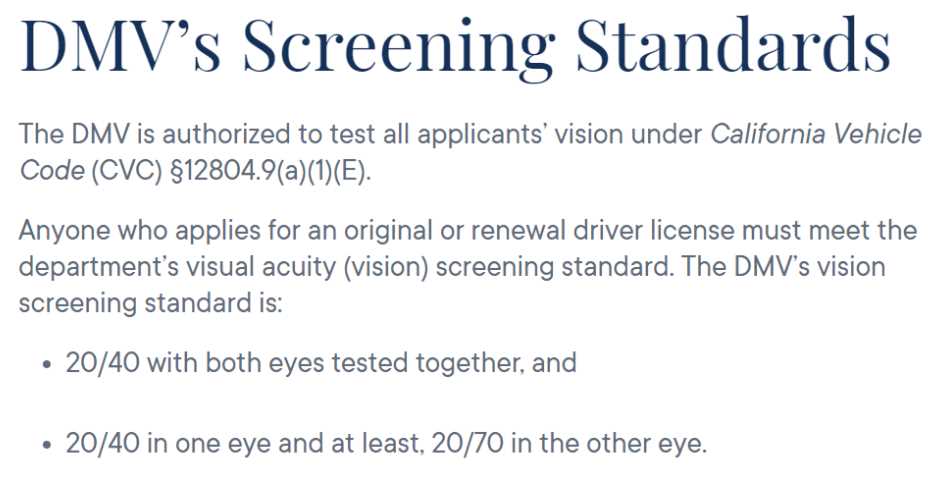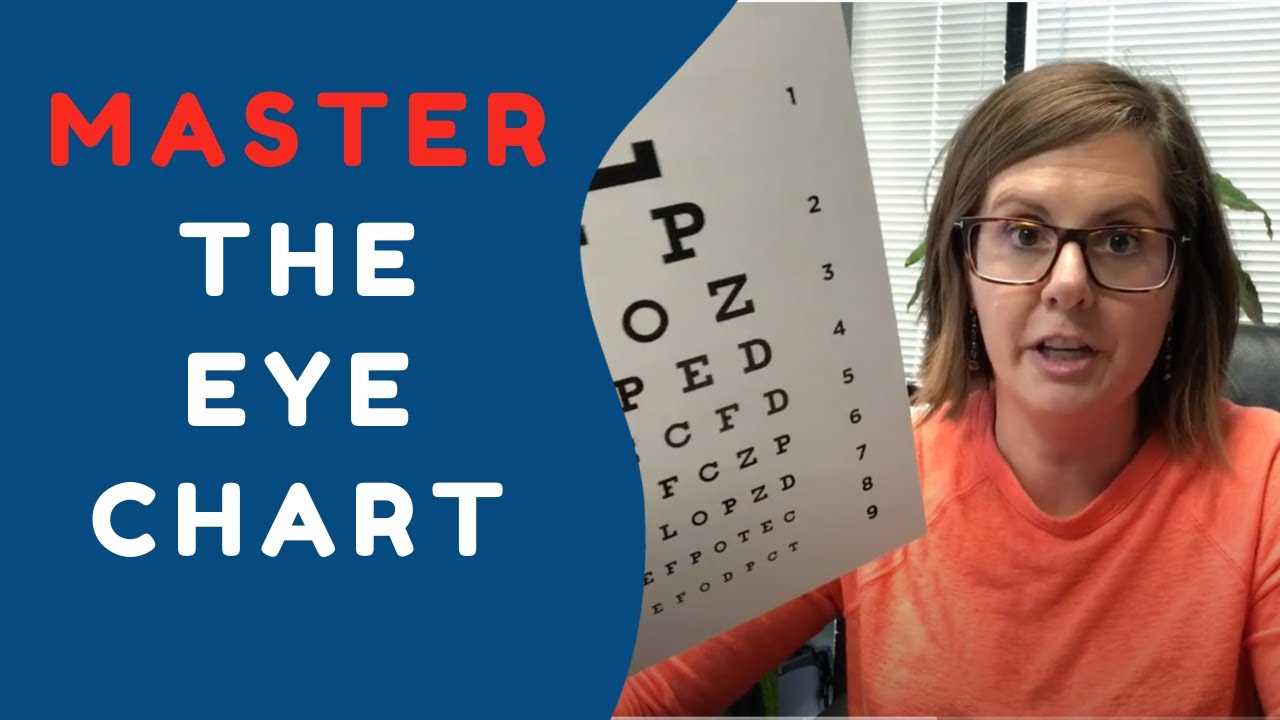
When applying for a driver’s license, one of the essential requirements is passing a vision assessment. This process ensures that individuals can see clearly enough to drive safely, minimizing the risk of accidents. The test typically involves reading characters from a distance, but its specifics can vary depending on the regulations of the local authorities.
Understanding the criteria for passing this assessment is crucial for everyone preparing for the procedure. Whether you wear glasses or not, it’s important to be familiar with the guidelines and how they apply to different age groups and health conditions. Having a clear understanding can help you prepare and avoid any surprises on the day of your test.
For many, the most challenging part is knowing exactly what to expect. With some preparation and knowledge of the requirements, you can approach the test with confidence, ensuring a smooth and successful experience. In this guide, we’ll cover everything you need to know to navigate the process with ease.
DMV Eye Exam Overview
Before obtaining or renewing a driver’s license, applicants are required to undergo a vision test to ensure they can drive safely. The goal of this assessment is to confirm that individuals have the necessary visual acuity and focus to operate a vehicle responsibly. This is an essential part of the licensing process and varies depending on the state and age group of the applicant.
Typically, the test involves reading characters from a distance to measure clarity of vision. It can also assess depth perception and color recognition, as both are critical for safe driving. Understanding the key components of this assessment can help you prepare effectively.
- Distance vision: Reading a chart or identifying symbols from a set distance.
- Peripheral vision: Ensuring you can detect motion and objects from the sides.
- Color perception: Identifying traffic signals and signs correctly.
Applicants may be required to wear corrective lenses if their vision does not meet the minimum standards. Some states also allow individuals to take the test with the help of their glasses or contact lenses. The results of the test are typically recorded on your driving record.
Overall, the process is straightforward and designed to ensure that all drivers have the visual capacity to operate a vehicle safely, reducing the risk of accidents caused by poor vision.
Why DMV Eye Exams Are Required
Vision is one of the most important factors in ensuring road safety. Without adequate sight, a driver may fail to notice obstacles, changes in traffic signals, or other critical details on the road, increasing the risk of accidents. To prevent this, regulatory authorities require all drivers to undergo a vision assessment before issuing or renewing a driver’s license.
Ensuring Road Safety
The primary purpose of this assessment is to ensure that all drivers can safely navigate the road. Proper vision is essential for recognizing road signs, identifying pedestrians, and responding to sudden changes in traffic conditions. Without clear vision, even experienced drivers may struggle to make quick decisions or react appropriately to potential hazards.
Minimizing Accidents and Injury

Research has shown that individuals with impaired vision are more likely to be involved in accidents. By requiring all drivers to meet certain visual standards, authorities reduce the likelihood of such incidents, ensuring that only those who can properly see the road are allowed to drive. This helps protect not only the drivers but also passengers, pedestrians, and others sharing the road.
What to Expect During the Test
When you go in for the vision assessment required for your driver’s license, the process is generally quick and straightforward. The purpose of the test is to measure your ability to see clearly at various distances, ensuring that you are fit to drive safely. Here’s what you can expect when you arrive for the evaluation.
The test usually begins with you standing or sitting a few feet away from a vision chart. You’ll be asked to read characters, numbers, or symbols displayed on the chart, starting with the largest and progressing to smaller ones. This measures your ability to recognize objects at a distance, which is essential for driving.
If necessary, you may also be tested for peripheral vision, which is crucial for detecting movement from the sides while driving. The entire process typically takes only a few minutes, and the results are recorded on your driving record.
Common Questions About DMV Vision Tests
When it comes to the vision test required for a driver’s license, many people have questions about the process and what to expect. This section answers some of the most frequently asked questions, providing clarity about the requirements and procedures involved.
What Happens If I Can’t Pass?
If you are unable to meet the required visual standards during the assessment, there are typically options available. You may be asked to retake the test after wearing corrective lenses or seeking treatment. In some cases, you might be referred to an eye specialist for further evaluation. If you pass the test with corrective lenses, they will be noted on your driving record, and you’ll need to wear them while driving.
Do I Need Glasses to Take the Test?
While you don’t necessarily need to wear glasses or contact lenses to take the vision test, it’s important that your vision meets the required standards for safe driving. If you normally wear corrective lenses, it’s a good idea to bring them to ensure accurate results. Failing to meet the minimum requirements may require you to wear glasses or contact lenses while driving.
Remember: The primary goal of this test is to ensure that you have the visual ability necessary to drive safely. Whether with or without corrective lenses, it’s essential to pass the test to obtain or maintain your driver’s license.
Preparing for Your DMV Eye Exam
Preparing for the vision assessment required for your driver’s license can make the process smoother and help ensure that you meet the necessary standards. A little planning in advance can go a long way in ensuring you are fully prepared for the test.
First, it’s important to get a good night’s rest before your test. Fatigue can impact your ability to see clearly, so being well-rested will help you perform better. If you wear corrective lenses, make sure to bring them with you, as you’ll need them to pass the test if your vision doesn’t meet the required standards.
It’s also a good idea to schedule an appointment with an eye specialist if you’ve had any concerns about your vision recently. A professional eye exam can ensure that your eyesight is up to par before you take the test. Don’t forget to bring your current prescription if you need corrective lenses for the test.
Finally, familiarize yourself with the vision chart or symbols that may be used during the assessment. While you won’t need to study extensively, having a general idea of what to expect can help reduce any anxiety and make the process easier.
Understanding the DMV Vision Chart

The vision chart used during the licensing process is designed to assess how clearly you can see objects at various distances. Understanding how the chart works and what it measures can help you feel more prepared when taking the test. This section explains the key features of the chart and how it relates to your ability to drive safely.
How the Chart Works
The chart typically displays letters, numbers, or symbols in decreasing sizes as you move down the rows. You will be asked to read these from a set distance, usually around 20 feet. Your ability to read the smallest line indicates the clarity of your vision. If you can identify the smallest characters, it means your visual acuity meets the required standards.
Common Features of the Chart
- Top Row: The largest characters, often representing the best level of visual clarity.
- Lower Rows: Smaller characters that assess your ability to see objects at a distance.
- Distance Measurements: The chart may indicate distances at which different lines should be read, typically starting at 20 feet.
While the most common chart is the Snellen chart, some locations may use variations with different symbols or numbers. Understanding how the chart is organized and what each row represents can help you feel more confident during the test.
Pass or Fail DMV Vision Criteria
During the vision assessment for your driver’s license, there are specific standards that determine whether you pass or fail. These criteria ensure that all drivers have the necessary visual abilities to operate a vehicle safely. Understanding the basic requirements can help you prepare and know what to expect during the process.
The most common criterion involves visual acuity, which refers to how clearly you can see at a distance. Typically, a minimum score of 20/40 vision in one or both eyes is required. This means you must be able to read characters from 20 feet away that a person with normal vision could read from 40 feet.
If you fail to meet the visual standards, corrective lenses may be required. In some cases, additional testing or a referral to an eye specialist may be necessary. It’s important to note that each jurisdiction may have slightly different requirements, so it’s always a good idea to check with your local licensing office for specific details.
How to Improve Your Vision for the Test
Preparing for the vision assessment required for your driver’s license involves more than just showing up on the day of the test. If you want to ensure the best possible results, there are several steps you can take to improve your vision before the evaluation. By following these tips, you can increase your chances of passing and avoid unnecessary delays.
One of the most effective ways to enhance your visual clarity is by getting adequate rest the night before the test. Fatigue can strain your eyes and impair your ability to see clearly. Additionally, staying hydrated helps maintain eye health, as dehydration can lead to dryness and discomfort, making it harder to focus.
If you wear corrective lenses, make sure to bring them to the test and ensure they are in good condition. If you don’t already have them, consider scheduling an eye exam with an optometrist beforehand to check if glasses or contact lenses might help improve your vision.
Lastly, avoid staring at screens for extended periods before the test. Taking regular breaks from digital devices can reduce eye strain and improve your ability to focus. A few minutes of looking at objects in the distance can help relax your eyes and improve visual performance.
DMV Eye Exam for Senior Drivers
As people age, changes in vision can affect their ability to drive safely. To ensure that older drivers meet the necessary visual standards, additional assessments may be required when renewing a driver’s license. This section covers what senior drivers can expect and how to prepare for the vision assessment.
Vision Changes in Older Adults
With age, it’s common for vision to decline, including conditions such as presbyopia, cataracts, or age-related macular degeneration. These changes can impact the ability to see clearly at various distances, which is why it is important for older drivers to undergo regular vision tests. Meeting the minimum visual requirements is essential for ensuring safe driving on the road.
What to Expect During the Test
Senior drivers will generally follow the same procedure as other drivers, but the test may be more focused on assessing overall clarity and depth perception. If any issues are identified, corrective lenses or other treatments may be recommended. Additionally, some states may require more frequent vision assessments for older drivers to ensure continued road safety.
Tip: It’s a good idea for senior drivers to schedule regular eye checkups with an eye care professional, even before the license renewal process. This proactive approach can help catch any issues early and avoid complications when it’s time for the assessment.
What Happens if You Fail the Test
If you do not meet the required visual standards during the assessment, you may not pass the test on the first attempt. However, failing the test does not necessarily mean you cannot obtain or renew your driver’s license. There are several steps you can take to address the situation and improve your chances of passing in the future.
Options After a Failed Test
If your vision does not meet the necessary requirements, you may be asked to retake the test after making adjustments, such as wearing corrective lenses. In some cases, you might be given the option to take a more comprehensive test with the assistance of an eye care professional. Depending on the specific rules in your location, you might also be referred to an optometrist for further evaluation and treatment.
Corrective Measures and Follow-Up
After failing the assessment, it is crucial to follow any recommendations provided by the testing authority. This may include obtaining prescription glasses or contact lenses, undergoing medical treatment for vision-related issues, or even adjusting your driving habits. Once your vision has improved, you can retake the test or provide proof of improvement to complete your licensing process.
Remember: Failing the test does not prevent you from getting a driver’s license as long as you take the necessary steps to meet the required visual standards.
Medical Conditions Affecting Your Vision
Several medical conditions can significantly impact the clarity and focus of your vision, making it harder to meet the required standards for driving. Understanding these conditions and how they affect your ability to see can help you take proactive steps to manage them. Early detection and treatment are key to preventing vision-related issues from affecting your safety on the road.
Common Conditions That Impair Vision
- Cataracts: A clouding of the lens in the eye, leading to blurred vision and difficulty seeing in low-light conditions.
- Glaucoma: A condition that damages the optic nerve, causing gradual vision loss, especially in the peripheral field.
- Macular Degeneration: Age-related degeneration of the central part of the retina, resulting in difficulty seeing fine details and reading.
- Diabetic Retinopathy: Damage to the blood vessels in the retina due to diabetes, which can lead to vision impairment and blindness.
How to Manage Vision Problems
Regular eye exams are essential for identifying conditions that may impact your ability to see clearly. If you have any of the conditions listed above, working closely with your healthcare provider to manage and treat them can improve your chances of passing the vision assessment. Treatments such as surgery, medications, or corrective lenses can help restore or maintain your vision.
Important: If you experience sudden vision changes or other related symptoms, seek medical attention promptly. Early intervention can help prevent further damage and improve your quality of life.
Do You Need Glasses for the Test?
For many individuals, corrective lenses may be necessary to meet the visual requirements during the assessment. Whether you need glasses or contact lenses depends on the clarity of your vision and the specific standards set by the testing authority. Understanding when and why you may need corrective lenses can help you prepare and ensure you pass the test without complications.
When Are Glasses Required?
If you have trouble seeing clearly, particularly at a distance or in low-light conditions, corrective lenses may be required. However, it’s important to note that if you already wear glasses or contact lenses for driving, you must have them with you during the test. If you wear corrective lenses only occasionally, you might still be asked to take the assessment with them on.
What Happens if You Need Glasses
If you find that your vision doesn’t meet the required standards, you may be asked to wear glasses or contact lenses for the remainder of the test. If you do not have them with you, you may be unable to complete the assessment until you are able to meet the requirements.
| Condition | Do You Need Glasses? |
|---|---|
| Clear Vision without Assistance | No |
| Blurred Vision at a Distance | Yes |
| Difficulty Seeing in Low Light | Yes |
| Occasional Use of Glasses | Yes |
Tip: If you’re uncertain about whether you need corrective lenses, it’s a good idea to visit an optometrist for a comprehensive eye checkup before the test.
DMV Vision Test and Driver’s License Renewal
When renewing your driving privileges, one of the requirements may include meeting certain vision standards to ensure that you are fit to drive safely. Depending on the state or region, a vision assessment is typically part of the renewal process. This is designed to confirm that your sight is adequate for operating a vehicle and that any potential vision issues are addressed in a timely manner.
The vision test for license renewal is usually straightforward, involving a quick check of your ability to see clearly at various distances. If you already wear corrective lenses, you may need to bring them with you to the renewal appointment. In some cases, if a deficiency is detected, additional steps may be required before your license is renewed.
Important: If you have had recent changes in your vision, it’s advisable to visit an optometrist before the renewal process to ensure that you meet the necessary standards and to avoid any complications.
Common Vision Problems Tested by DMV
During the testing process, several common visual issues are assessed to ensure that individuals can operate a vehicle safely. These problems often include difficulties with clarity, distance perception, and the ability to see in low-light conditions. Identifying such issues early on can help in making necessary adjustments, such as corrective lenses or other treatments, to maintain safe driving standards.
| Vision Problem | Description |
|---|---|
| Blurry Vision | Difficulty in seeing clear details, especially at a distance. |
| Night Blindness | Inability to see well in low-light conditions or darkness. |
| Color Blindness | Challenges in distinguishing between certain colors, especially red and green. |
| Peripheral Vision Loss | Reduced ability to see objects outside of your direct line of sight. |
| Depth Perception Issues | Difficulty judging the distance between you and other objects, making it harder to navigate safely. |
Note: If any of these issues are detected, corrective measures such as glasses, contact lenses, or even further medical evaluation may be recommended before proceeding with the licensing process.
How Long Does the Eye Exam Take
The duration of a vision assessment required for obtaining or renewing a driver’s permit is generally quite brief. In most cases, the process can be completed in just a few minutes. The test is designed to quickly check whether your vision meets the necessary standards for safe driving, and it typically does not require a lot of time.
Factors Affecting the Duration
The time it takes to complete the vision check can vary depending on a few factors:
- Type of Test: Some locations may use basic vision charts, while others may employ more specialized equipment.
- Your Visual Health: If you need additional tests due to known issues or recent changes in vision, this may extend the process.
- Staff Efficiency: The experience and speed of the technician performing the test can also influence the overall time.
What to Expect
In most cases, the entire procedure will be relatively quick, taking between 5 and 10 minutes. Afterward, the results are reviewed, and you will be informed whether any further steps are required based on your performance.
Tips for Passing the DMV Vision Test
Preparing for a vision assessment is essential to ensure you meet the necessary standards for driving. While the process may seem simple, taking a few steps beforehand can help you perform at your best. Below are some practical tips to help you pass the vision test with ease.
1. Make Sure Your Glasses or Contacts Are Up to Date
If you wear corrective lenses, it’s important to ensure that they are in good condition. Old or scratched glasses can affect your ability to see clearly during the test. Make sure your prescription is current and that your lenses are clean before the assessment.
2. Rest Your Eyes Before the Test
Like any other part of your body, your eyes need rest to function properly. Avoid staring at screens or reading for extended periods before the test. Taking short breaks and resting your eyes will help improve their clarity during the test.
3. Stay Calm and Focused
Stress can affect your vision, making it harder to concentrate during the test. Try to stay calm and focused, as anxiety can cause temporary vision issues. Deep breaths and a relaxed mindset will help you perform your best.
4. Know What to Expect
Familiarizing yourself with the test setup can help reduce any anxiety. Understanding that the test typically involves reading letters or shapes from a chart can help you feel more confident going in. The more relaxed you are, the better you’ll perform.
5. Don’t Hesitate to Ask for Assistance

If you struggle to read the chart or have trouble seeing certain letters, don’t hesitate to ask the technician for help. Some locations may offer alternative testing methods or allow you to take the test at a closer distance.
6. Regular Eye Exams
Regular eye checkups are important, not only for passing tests but for maintaining your overall visual health. If you notice any changes in your vision, consult an optometrist before taking the test.
By following these simple tips, you can ensure that you are well-prepared for your vision test and increase your chances of passing on the first try. Always remember that your visual health plays a key role in keeping both you and others safe on the road.